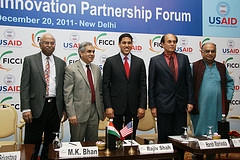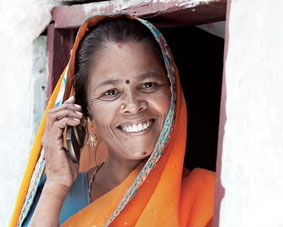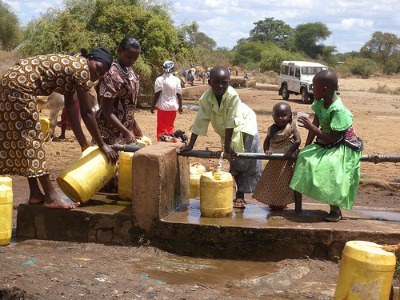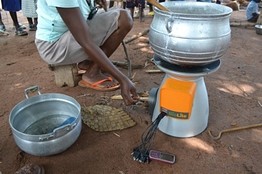
THOMAS MUKOYA/REUTERS - Somali refugee girls attend Koran classes at the Liban integrated academy at the Ifo refugee camp in Dadaab, near the Kenya-Somalia border, August 2, 2011.
This blog is part of a series where the Washington Post posed questions to nonprofit, industry and academic leaders on innovation. The following is the Q&A between Kate Roberts from PSI and the Washington Post.
By Kate Roberts. Published November 8, 2011.
This year has seen a famine declaration in Somalia and the birth of the 7 billionth human being. As the nation continues to expand and the economy continues to contract, it is necessary for organizations dedicated to global development to be able to remain agile in order to innovate. To find out more about what leading groups are doing to keep up with the fast pace of change, we asked PSI Vice President for Corporate Marketing and Communications, Kate Roberts, to answer five questions on the current landscape in global development and what she has her eye on in terms of new innovations in the field.
1. The famine declaration in Somalia made news in the first week of August, highlighting the shortage of resources in the region, among them the availability of clean drinking water. Which methods have stood out to you as the most effective in providing safe drinking water in the region?
We often take the water we drink for granted, but nearly a billion people worldwide go without this basic resource. Every 20 seconds a child dies from drinking dirty, unsafe water and I believe it’s our responsibility to do everything we can to prevent those deaths from happening.
Providing safe drinking water for a billion people in need is a big challenge. Part of the problem is the lack of infrastructure and well-designed water and sanitation systems in many parts of the world. Unfortunately, those are long-term problems that require long-term solutions. In the meantime, we need to focus on saving lives now.
At PSI, we’ve found the most effective way to get safe drinking water to people in need is through household water treatments – it’s an inexpensive and easy-to-use solution that gives everyone the opportunity to treat unsafe water in their homes. Here is one way we’re making this possible: Procter & Gamble, one of our corporate partners, has a highly effective water purification product called PUR. Since the vast majority of the population in the developing world goes to private sector providers for health care, PSI makes sure that PUR is available at an affordable price in private sector shops, kiosks and pharmacies.
We make the products available and affordable through the private sector, and use commercial marketing techniques to increase demand. This means we are able to create an attractive market for the private sector and thereby increase the likelihood that more private shops will stock PUR and more people can access it.
At the same time, we know the public sector is an equally important player in health so we often make our products available through the public sector as well. After the earthquake in Haiti, for example, PUR and other water purification products were available for free through the public sector for those who couldn’t afford to access it in the private sector. This combination of public and private sector distribution is undoubtedly one of the most effective methods out there. PSI has already provided more than 40 billion liters of safe drinking water to people in need through these channels.
2. There is a push now to do away with the traditional forms of charitable giving in developing countries. What forms of assistance are moving in to take their place?
My personal passion is convincing corporations to become our partners in health. Non-profits can really benefit from strategic corporate partnerships and corporations get a lot out of those partnerships as well.
For corporations, non-profits give access to the bottom billion of the socio-economic pyramid. As people in the bottom billion gain more economic power and start climbing higher, they become a valuable customer base. In addition, the good work corporations do to help the bottom billion is often noted and appreciated by customers in the developed world as well.For non-profits, corporations not only provide support for those in need, they can also teach us a lot. For example, PSI pioneered the use of proven business strategies in global health programs and we incorporate a marketing perspective in everything we do, accompanying our health services and products with robust communications and marketing campaigns to ensure they’re widely accepted and properly used.
One of our most effective corporate partnerships is with Johnson & Johnson. Together, we created a program in Uganda called “Go-Getters,” which empowers young women to take charge of their health and their lives. We’ve partnered with Nike around the Girl Effect, placing PSI Fellows in their organization to help them better assess the impact of programs aimed at women and girls on the ground.
In the end, these programs present a win-win-win scenario — a win for corporations, non-profits and for the vulnerable groups that we serve.
3. Given the wide-spread need for assistance around the world and on so many fronts, is it possible to be a successful lone actor? And, if so, how do you recommend one go about it?
PSI long worked as a lone ranger, avoiding energy-sapping meetings and conferences because we just wanted to “get it done.” In recent years, we’ve changed considerably and made strides toward being an active partner and collaborator. We do this because it’s clearly the best way to amplify our collective impact and alleviate the burdens of suffering among our target audience. Now, whenever we start a new program or initiative, we look at the partners that are already involved, assess their strengths and weakness against our own and then figure out a way forward that will create the greatest impact. The last thing we want to do is waste our donors’ money by trying to reinvent the wheel: starting a project from scratch when others have the expertise to do the job well. With that said, there are still times when it can be worth the risk to go it alone. A good example of that is our work in male circumcision. Male circumcision reduces HIV transmission by 60% among heterosexuals, which is more effective than any vaccine currently in development. But when male circumcision first appeared as an HIV prevention tool, not everyone was immediately ready to invest in the approach. PSI decided it was worth it. We invested our own money in a pilot program and to prove that male circumcision worked. Then we recruited others — like the Gates Foundation and USAID — to support the initiative. With their help, we were able to scale up the program across Southern Africa.Could we have done the scale up alone? Absolutely not. But we needed to act alone in the beginning to prove that the intervention could work. This goes to show that once in a while being a lone actor — for a short time — can work.
4. Innovation is not always the result of success. Has PSI ever failed in its duties and, if so, what has the organization learned from that failure?
Innovation is imperative. But to be honest, not all the innovations we’ve invested in at PSI have been successful. This isn’t because we chose the wrong interventions – quite the contraryFor example, the distribution of eyeglasses to people living in poor and vulnerable parts of the world, or providing multivitamins as nutritional supplements are all worthy pursuits. In our case, what we failed to do well was to put an adequate amount of resources behind these great ideas. We were only willing to dip our toe in the water. Wee weren’t ready to cannonball in.
Our lesson learned was that if we’re going to innovate, we have to do it wholeheartedly. As a result, we’ve invested millions of discretionary dollars in an Innovations Fund that allows us to experiment with new ideas that PSI believes in but that donor agencies aren’t yet ready to support. This spirit of innovation is an essential component of PSI’s corporate culture. When we’ve proven an intervention works — like with male circumcision or with the work we’re doing now to treat drug overdoses in Russia — donor governments and agencies follow our lead and help take the innovations to scale.
5. What is the latest innovation that you are currently following?
Social franchising — it’s where MacDonald’s meets health care. I know we don’t normally think of those two things in the same sentence, but the most innovative techniques in global health borrow as much from a Big Mac as they do from the World Health Organization. Social franchising provides private businesses that supply health products the opportunity to benefit from access to NGO or government training, supplies, and other economies of scale. However, where private sector franchises usually pay licensing or profit-sharing fees, social-franchisees are usually required only to meet quality standards and actually receive health products at highly subsidized prices. It’s a way of delivering health products and services that ensures that they’re accessible, affordable and desirable to all those in need.
Our number one priority now is taking social franchising to scale, and we have the platform to do it. In the future, we’re hoping to engage even more private sector companies and strategic partners who see the value in our established network.
 New Delhi – Nearly 80 years ago, Mohandas Gandhi addressed FICCI members at one of the organization’s annual meetings.
New Delhi – Nearly 80 years ago, Mohandas Gandhi addressed FICCI members at one of the organization’s annual meetings. Kudos to Secretary of State Hillary Clinton, USAID Administrator Raj Shah, Johnson & Johnson CEO William Weldon, and their colleagues at the United Nations Foundation, the mHealth Alliance, and BabyCenter on the launch of the Mobile Alliance for Maternal Action, a new public-private partnership to improve maternal and child health by harnessing the power of mobile technology to deliver vital health information to expectant and new mothers.
Kudos to Secretary of State Hillary Clinton, USAID Administrator Raj Shah, Johnson & Johnson CEO William Weldon, and their colleagues at the United Nations Foundation, the mHealth Alliance, and BabyCenter on the launch of the Mobile Alliance for Maternal Action, a new public-private partnership to improve maternal and child health by harnessing the power of mobile technology to deliver vital health information to expectant and new mothers. Poor households and neighborhoods simply can’t afford the huge capital costs that are required to produce extensive water systems, solid waste facilities, and graded highways. Those investments, typically ranging in the millions to hundreds of millions of dollars, are almost always financed by municipal bonds, which are themselves sourced from national treasuries or loans from international financial institutions like the World Bank.
Poor households and neighborhoods simply can’t afford the huge capital costs that are required to produce extensive water systems, solid waste facilities, and graded highways. Those investments, typically ranging in the millions to hundreds of millions of dollars, are almost always financed by municipal bonds, which are themselves sourced from national treasuries or loans from international financial institutions like the World Bank.







